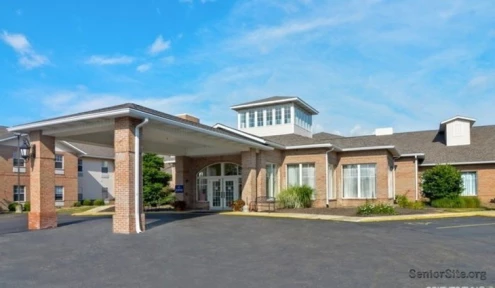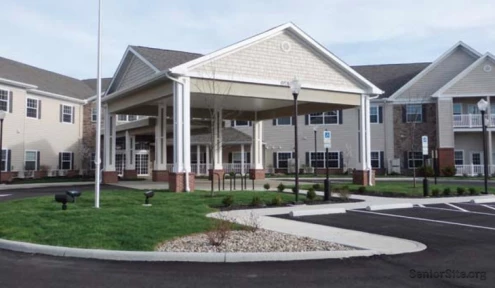Nearly 10 million older adults struggled to pay for housing before the COVID-19 pandemic began. The number has grown significantly with today’s skyrocketing inflation and rising rents.
Housing costs represent the largest expense in household budgets for adults over 55. Several government programs exist to address this challenge for seniors living on fixed incomes. The Housing Choice Voucher Program, public housing, and subsidized apartments offer potential solutions for those receiving Social Security benefits.
Options range from independent living arrangements to assisted care facilities. The process of securing affordable housing while living on Social Security benefits involves specific steps and documentation requirements. Each program has different eligibility criteria and application procedures.
Seniors seeking housing assistance can apply for various federal programs through local housing authorities. Wait times vary by location and program type. Some regions prioritize applicants based on age, income level, or special needs status.
Housing Options for Seniors Receiving Social Security Benefits
Social Security provides essential income for millions of seniors, but finding affordable housing on these limited payments presents significant challenges. Federal and local programs offer specific housing solutions for older adults living on fixed incomes.
Available affordable housing programs
The Department of Housing and Urban Development (HUD) sponsors several programs designed for senior housing needs. The Section 202 Supportive Housing for the Elderly Program provides apartments exclusively for adults 62 and older with limited financial resources. The Housing Choice Voucher Program (Section 8) allows qualifying seniors to rent from private landlords at reduced rates.
Public housing offers another option, with eligible low-income seniors receiving apartments or homes managed by local housing authorities. Adult family homes provide group living environments for up to six seniors in licensed residential settings. Home sharing arrangements enable homeowners to generate additional income while offering affordable living spaces to others.
Understanding income eligibility requirements
Income requirements for senior housing assistance follow categories based on the Area Median Income (AMI). These categories include extremely low income (15-30% of AMI), very low income (30-50% of AMI), and lower income (50-80% of AMI).
For Section 8 housing, household income must not exceed 50% of the median income limit in the applicant’s area. Section 202 supportive housing similarly requires applicants to fall within the “very low-income” bracket—below 50% of the AMI. The Low Income Housing Tax Credit (LIHTC) program typically requires participants to earn between 30-70% of the area’s median income.
Most housing assistance programs calculate costs as a percentage of resident income. Participants generally pay 30% of their adjusted gross income toward rent and utilities.
Subsidized versus income-based housing differences
Subsidized housing involves government payments made directly to housing agencies or landlords to cover portions of market-rate rent. Income-based housing calculates rent specifically according to the tenant’s income level.
With Section 8 vouchers, recipients pay 30% of their monthly income toward rent while the government pays the difference between this amount and the actual market rent. In public housing, rent is set at approximately 30% of a household’s adjusted income regardless of market value.
Section 202 housing combines both approaches. Residents pay 30% of their adjusted gross income for rent, with the program subsidizing the remainder. This structure ensures housing remains affordable despite fluctuations in residents’ fixed incomes.
Preparing Your Application for Senior Housing Assistance
Proper documentation and accurate financial reporting significantly improve your chances of securing senior housing assistance. Housing authorities require specific paperwork and detailed financial information to determine eligibility for their programs.
Required documentation for applications
Housing authorities verify applicant information through several mandatory documents. When applying, you’ll need to provide:
- Photo ID for all household members 18+ years old
- Birth certificates and Social Security cards for everyone in your household
- Proof of income including Social Security award letters, pension statements, and recent bank statements
- Four consecutive pay stubs (if employed) or notarized income statements
- Current and previous landlord contact information
- Medical records and reports for special accommodation requests
Your application status updates will be sent to your listed contact information, making it essential to keep these details current throughout the process.
How to report income and assets
Housing authorities calculate your Total Tenant Payment (TTP) based on your anticipated gross annual income minus allowable deductions. Accurate income reporting directly affects your housing assistance eligibility.
HUD regulations allow specific deductions: $480 for each dependent, $400 for elderly families or persons with disabilities, and certain medical expenses for elderly-headed households. The Housing Opportunity Through Modernization Act (HOTMA) disqualifies families with net assets exceeding $100,000 or those owning suitable real property.
Assets under $50,000 typically qualify for self-certification, though you must report any expected income from these assets. Housing authorities verify all assets every three years to ensure continued program compliance.
Application assistance resources
The application process often involves lengthy forms with detailed information requirements. Senior centers frequently offer free application assistance services. If you cannot complete the application yourself, another person may submit it on your behalf.
Some programs, particularly Section 202 or LIHTC properties, charge application fees. Processing timelines vary considerably—applications typically take several weeks or months to review. Housing counselors and social workers can provide guidance through the application process, potentially making the difference between approval and rejection.
Starting the application process early and thoroughly preparing all required documentation significantly increases your chances of securing affordable housing while living on Social Security benefits.
Application Process for Low Income Housing Programs
The application procedures for low-income housing programs differ depending on program type. Each program has specific requirements and submission methods. Housing authorities evaluate applications based on established eligibility criteria.
Section 8 housing voucher application process
Section 8 assistance applications begin with contacting the local Public Housing Authority (PHA). PHAs only accept applications during specific enrollment periods, which applicants must verify before attempting to apply. Application submission options include:
- Online through the official PHA website
- Paper forms requested by mail
- In-person at the housing authority office
The application process is free but requires comprehensive information about household members, income sources, and residency status. After submission, applicants enter a waiting list until vouchers become available. The PHA may prioritize certain applicants based on need, particularly those in unsafe living conditions.
Public housing application procedures
Public housing applications start by contacting the local Housing Authority (HA). Applicants must complete a written application either independently or with assistance from an HA representative. The application typically requires:
- Names, birth dates, and relationships of all potential household members
- Current contact information
- Family characteristics that might qualify for preferences
- Landlord references
- Income estimates and sources
After application submission, the HA sometimes conducts home visits to assess how applicants manage their current living situations. Applicants subsequently receive written notification regarding eligibility and waiting list status.
Section 202 Supportive Housing application steps
Section 202 housing applications differ from Section 8. Applicants must first contact their local HUD office to identify participating properties. Applications go directly to property managers rather than through HUD. Most properties require:
- Completing an application (online, by phone, or in person)
- Paying an application fee
- Providing documentation proving the applicant meets the age requirement (62+)
- Verifying “very low-income” status
Applicants remain on the property’s waiting list until their application processing completes, which typically takes weeks or months. The final eligibility determination involves an in-person interview with property management.
Navigating Waiting Lists and Finding Immediate Housing Solutions
Waiting lists for affordable senior housing can extend from several months to multiple years. Various alternatives exist for seniors who need housing while waiting for permanent options to become available.
How waiting list priorities work
Waiting lists determine the order in which housing authorities offer units to qualified applicants. Most senior housing programs operate on a first-come, first-served basis, making early application essential. When waiting lists open, some housing authorities use lottery systems to determine applicant placement. Certain factors can affect list position—many PHAs prioritize seniors living in unsafe conditions or those with urgent medical needs.
Housing authorities periodically request application updates. Failing to respond to these requests typically results in removal from the waiting list. Declining multiple housing offers may also cause demotion to the bottom of the list.
Emergency housing alternatives
Seniors needing immediate housing assistance can dial 2-1-1 to connect with United Way services that provide access to local shelters and transitional housing options. This service requires no formal application process and can also connect seniors with food assistance and mental health support services.
The Federal Emergency Rental Assistance Program continues to operate in many states, offering temporary financial support for rent and utilities. Veterans facing housing insecurity should consider:
- HUD-VASH program providing housing vouchers plus case management services
- Enhanced-Use Lease program converting underutilized properties for veteran housing
Home sharing arrangements
Home sharing matches seniors who have extra living space with those seeking affordable housing, addressing both financial constraints and social isolation. Programs like SeniorHomeshares.com facilitate these arrangements without charging fees.
Typical home sharing arrangements involve homeowners offering private bedrooms and shared common areas in exchange for rent, household assistance, or a combination of both. Participants create profiles detailing property information, budget, and preferences before algorithm-based matching occurs. Many programs implement safety measures including background checks and reference verification.
The National Shared Housing Resource Center maintains a state-by-state directory of home sharing programs.
Conclusion
Finding affordable housing on Social Security income presents significant challenges for seniors. Federal programs including Section 8 vouchers, public housing, and Section 202 supportive housing offer potential solutions, though each requires specific documentation and patience throughout the application process.
Housing security for seniors depends on thorough preparation and adherence to program requirements. Documentation of income and assets, accurate financial reporting, and consistent communication with housing authorities determine application success. Waiting periods for permanent housing often extend for months or years, making temporary options like home sharing and emergency assistance programs valuable interim solutions.
The application processes for different housing programs follow similar patterns but contain important variations. Housing authorities evaluate eligibility based on income thresholds, age requirements, and other factors that vary by program and location. Early application submission improves chances of securing housing due to the first-come, first-served nature of most waiting lists.
Local housing counselors and senior centers provide assistance with navigating complex application procedures. Seniors seeking housing help can contact multiple programs simultaneously to increase their chances of placement. Housing authorities periodically update waiting lists, making it essential to maintain current contact information throughout the application process.
Senior housing programs continue to evolve with changing federal policies and funding availability. Housing needs assessments by local authorities determine priority status for certain applicants, particularly those in unsafe living conditions or with urgent medical requirements.
FAQs
Q1. What housing options are available for seniors on Social Security? There are several affordable housing programs for seniors on Social Security, including the Section 202 Supportive Housing for the Elderly Program, Section 8 Housing Choice Voucher Program, and public housing. These programs offer various options such as apartments, vouchers for private rentals, and income-based housing to help seniors live independently within their means.
Q2. How do I qualify for senior housing assistance programs? Eligibility for senior housing assistance typically depends on your income level. Most programs require applicants to fall within the “very low-income” bracket, which is usually below 50% of the Area Median Income (AMI). You’ll need to provide documentation of your income, assets, and other personal information when applying.
Q3. What documents do I need to apply for senior housing assistance? Essential documents for applying include photo ID, birth certificates, Social Security cards for all household members, proof of income (such as Social Security award letters and bank statements), and contact information for current and previous landlords. Medical records may also be required if you need special accommodations.
Q4. How long is the typical waiting list for senior housing? Waiting lists for senior housing can vary greatly, ranging from several months to years. The length depends on factors such as location, type of housing, and demand. It’s important to apply early and keep your application updated to maintain your position on the list.
Q5. Are there any immediate housing solutions for seniors in urgent need? Yes, there are emergency options for seniors needing immediate housing assistance. You can dial 2-1-1 to connect with United Way services for information on local shelters and transitional housing. Additionally, home sharing programs and the Federal Emergency Rental Assistance Program can provide temporary solutions while waiting for long-term housing options.












